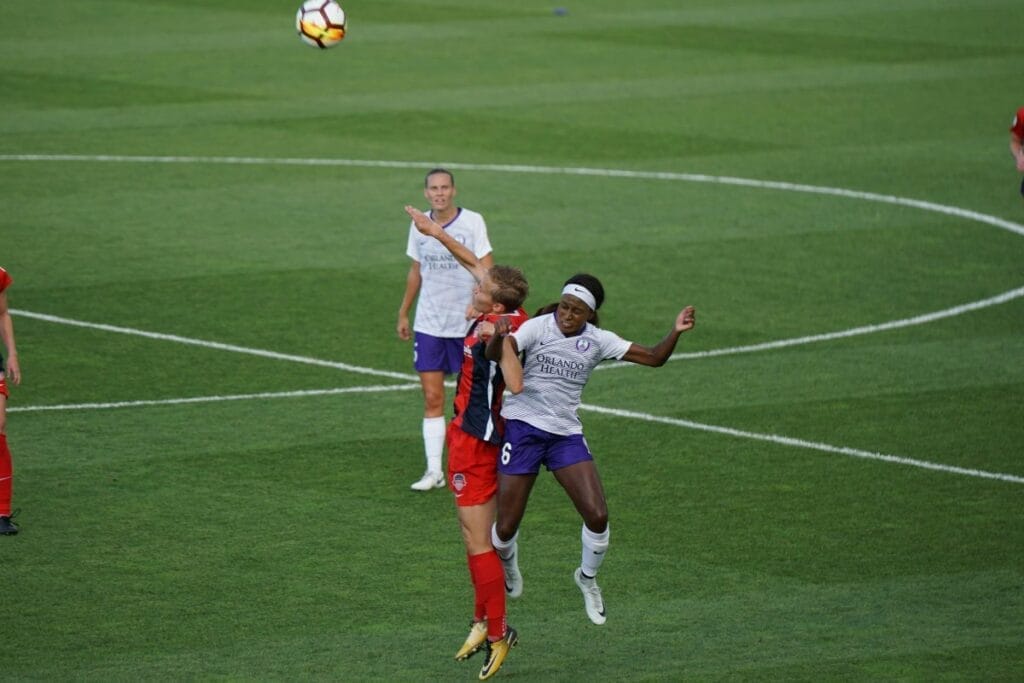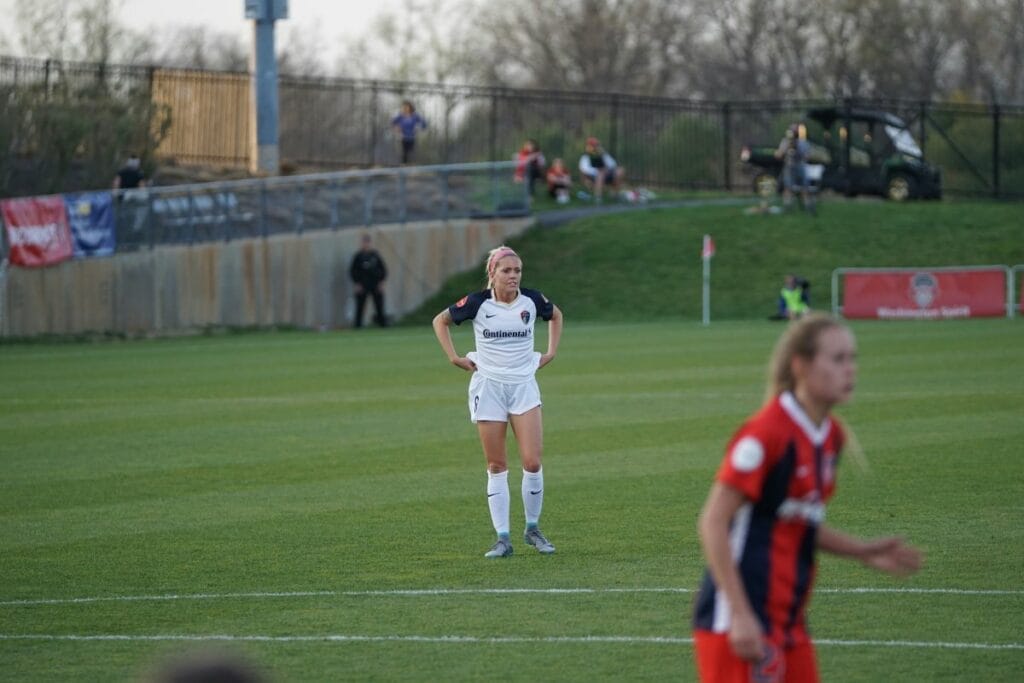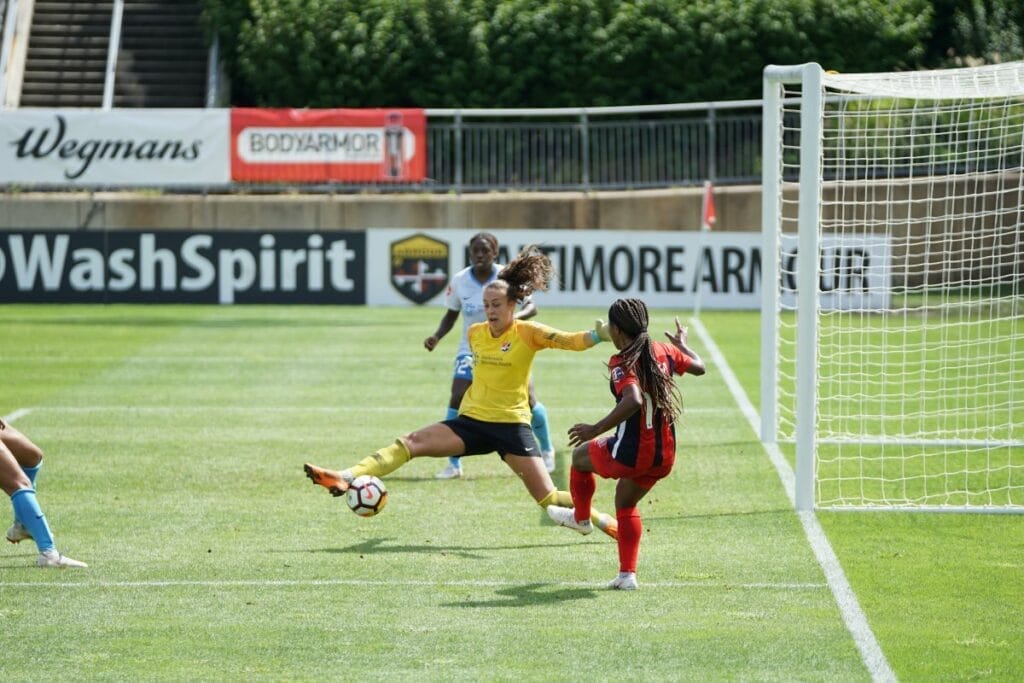This post contains affiliate links for which I may make a small commission to help keep the site running. You will not be charged extra for these items had you not clicked the links. Thank you for your help to keep the site running!
Did you know there’s a major difference in football or soccer stadium rules in England versus the USA?
Or that the gender divide in the sport is actually swapped in both countries?
While I am not the world’s foremost expert on football or soccer, whatever you want to call it, I did play at least 2 seasons on a team as a 7-9 year old because my best friend was actually talented in the sport and the only way I could get to hang out with her more was to pretend I liked it too.

I’ve also done a ton of research into the different football/soccer cultures in England and USA, so for both of those reasons I feel fully qualified to be deep diving into football in England and soccer in the USA and how actually the sport is experienced differently in many ways in both countries.
I also will have you know that I did score a goal during my career, and yes it was on accident and it was for the other team but those are just small details.
Also they spelled my name wrong on the end of season trophy so there’s that.

Anyway.
I’ve lived in England for 10 years and in that 10 years I’ve really come to experience how true it is that football is a hugely important sport here, one of the big powerhouse sports that tons of people follow, and I thought it would be interesting to share how it differs across the pond – and not just in the first, major difference, but many others.
Name

So difference 1, we’ll get this out of the way quickly – the sport, with 11 players on a side trying to kick a ball into the goal on the opposite team’s side, is called football in England and in most of the world.
It’s called soccer in America, but the term soccer actually originated from England and football used to be called soccer in England and used more interchangeably.
The sports full name when it was first made official in 1863 was “association football” to differentiate it from other forms of “football” in England at the tie, including rugby football, now just called rugby, and this got eventually shortened to “assoc football” and then made its way into “soccer.”
In the US, what we call football looks like this.
Boots vs Cleats

There are other language differences as well, two notable ones being that in England, these are called “football boots” and in the US, typically these are called “cleats” or “soccer cleats.”
Pitch vs Field

Another very commonly used difference within the sport – in England, this is called the “pitch,” or football pitch, whereas in the US we call it the “field” or “soccer field.”
Moving swiftly along, and before we get into the differences in the professional playing of the sport in each country, let’s talk about the recreational side of the sport because I find this incredibly fascinating.
Recreational Soccer and Football

In England, as you would expect, plenty of kids play football – around 30% of them.
This makes sense, given it’s arguably the most popular sport in the UK that there would be massive amounts of kids involved from a young age, who want to be like their favorite players and are continually exposed to the sport in culture.
In America, however, you might think that there would be lower participation, given that the US’s professional soccer culture is not as prominent – surely all of the kids are playing American football, baseball, and other sports?

And they are, sure, but they’re also playing soccer in very large numbers – in fact, my experience is backed up by questions you can find on the internet asking questions like, “why is soccer so popular with US kids but so unpopular with US adults?”
American kids, as a whole, love recreational soccer – it’s one of the cheapest, easiest, and most popular sports to get involved with despite the fact that we don’t necessarily grow up with major exposure to the sport in a non-recreational way.

I was not a particularly athletic kid and even I was thrown on a team to get some running around in on the weekends and while I think I looked forward to the snacks more than the actual sport, I wasn’t alone in that.
I found a very accurate quote on a Reddit thread from an American, which says “when I was enrolled in soccer as a kid, there were maybe 2 or 3 kids there that actually liked soccer. Most American kids don’t play soccer because they want to play soccer. They play soccer because their parents think they’re too young or too delicate to play another sport.”

Youth sports are incredibly popular in the USA, and soccer is one of them – you don’t need a ton of equipment and it’s a low risk sport to put your kid in if they decide next year to quit.
As they get older, many American kids will switch into the sports that bring more glory and fame in the US, including American football, basketball, baseball, and hockey, but being on a soccer team as a kid has been a widespread core memory for many Americans my age and still continues.
However, just because American kids are playing soccer in large droves doesn’t mean we’re doing it well.
Alex from We Make Footballers, who experienced youth football coaching in both England and the USA writes that the drills in England were more technical than those used in the US and that the foot skills of the youngest group of players in England was far superior to what the youngest groups of players in the US would have been capable of.

He noted that children often start earlier in England than in the US, and mentions the seasonal aspect of youth sport in the US compared to the UK.
Many American children will play a different sport per season, something like soccer in the autumn, baseball in the spring, basketball in the winter, etc, effectively ditching the sport that wasn’t in season until next year, whereas in England, he noticed more year-round training and styles when it came to what sport a child played.
Then we have the sort of “in between” years where you’re no longer playing youth sports but certainly not playing professionally – this is a fascinating divide as well, as this time in a person’s life, which sort of continues through adulthood as long as you’re playing recreationally, is different in both countries.

In England, there are plenty, and I mean plenty of adult football opportunities, I call it “village football” so that once you move on from youth sports, you can still play the game with other adults, typically male in England, which we’ll get into in a minute, but it is ingrained in the culture here and not uncommon – teams are often oversubscribed with too many players and not enough playing time in certain areas.
In the US, adult soccer leagues for recreational players do exist, so don’t think I’m saying they are nowhere to be found because they are, but even the more talented American older teenagers who play on their high school soccer teams and then go on to play on collegiate soccer teams will quit the sport after graduation.

This is a difference in the university and high school systems in the 2 countries as well – high school and college sports are incredibly popular within the US, and not so much in the UK unless you’re talking about something like potentially rowing, so non-professional players in America will often see the college route as their way of achieving their soccer dreams and getting to compete against colleges around the nation during their time at university as the “peak” of their participation in the sport, whereas recreational English players often treat it as a lifelong sport to continue playing, whether as pick up games or as part of the “village football” style leagues.
Gender

On that note, and to bring us into the professional levels, let’s talk about gender in football/soccer because this is another interesting difference in how the sport is perceived.
In England, while there have been recent victories in women’s professional football that have encouraged more girls to start playing, there exists a gender divide that skews male when it comes to the sport.
When we’re talking about recreational playing, only about 1 in 7, or about 15% of youth football players are girls, making the male component a solid 85%.
In the US, this split is much closer to equal, with some statistics saying around 60% male and 40% female when it comes to youth soccer but some saying an even 50% and 50% split.
In fact, overall, soccer in the US is incredibly popular among women – there are a couple of reasons for this.
Firstly, the US was an early adopter of women’s soccer and that means creating more development camps and trainings and future “goals to aspire” to for female soccer players in the US.
There was also an educational bill called Title IX in 1972 that made gender equality mandatory in education, which included collegiate athletics which led to more women’s sports teams and scholarships available.
And the final outcome, in addition to the talent developed within the US on the women’s side, is notoriety at the professional levels – the US women’s national team is more recognizable than the men’s national team based on surveys, and while the England women’s national team has definitely made major strides and is well supported by many fans, the men’s national football team in England is still far more “known” in England than the women’s overall.
Professional League

So now we’re talking professional football/soccer, let’s keep that ball rolling…
In England, the Premier League is arguably one of the world’s most prominent football entities, established in 1992 after the reform of what was called the Football League First Division.
They use a promotion and relegation system so teams throughout the league can be relegated or promoted yearly based on outcomes to the Premier League.
The closest American equivalent, MLS, or major league soccer is the foremost professional league in the USA and they do not use a promotion and relegation aspect.
There are ordered tiers in the US, but a club would only move between levels based on financial merit and not performance.
The history of this organization is also far younger – while the Premier League was technically established in 1992, it came from a long history of organized football within England.
MLS was established in 1993, but this was as one of the first established professional soccer structures within the US – for instance, all while growing up in Orlando, we didn’t have a professional soccer team to support until the Orlando City club was founded in 2013.
Soccer as a professional sport with followers and fans is much newer in the US than the UK and the league lacks the history and prestige of the English Premier League.
Match Day Experience

And finally, the match day experience for fans in England versus the USA – is again pretty different in some interesting ways!
Firstly, let’s just call it like it is – English fans of any club are far more dedicated and passionate than most American fans.
The number of supporters of the “away” team at a match of an English club is sizeable, while in the US, stadiums are much further away and in cities that are a plane ride away rather than a train ride away, so you find far fewer number of the opposite team’s supporters in a US professional soccer match.
The “American style” experience at a soccer game is seen as more family-friendly – a fun day out that you bought last minute tickets to because your friends are in town and you’re looking for something to do.
In England, it’s a far more passionate experience and even getting tickets to a Premier League match can be incredibly difficult as tickets mostly go to long time club supporters and season ticket holders and it’s not as easy as just deciding you want to go to a match last minute unless you have a significant amount of money to pay.
Because of this passionate atmosphere, there is a ban on alcohol being consumed in view of the pitch at football matches – this has been in place since 1985 in England and was started to try to curb hooliganism, which we’ll talk about in a minute.
There is no similar ban in the US.
Now it would be impossible to do a video about English football without mentioning the history of its fans as there have been some tragic incidents related to violence and what is known as “hooliganism” within England.
This was at its peak in the 1970s and 1980s and unfortunately England did gain a reputation for violent behavior, racist behavior, and crowd violence and offensive chanting, and there have been incidents even in recent years by the “bad apples” of football bans.
However, not all football fans even in the 70s and 80s can be painted with this brush, as the majority were just passionate people who wanted to watch football.
But with some cracking down on football related violence in the late 80s and well into the 80s, English football fans have earned a better reputation and the incidents are now more scattered and don’t usually happen at the matches themselves, which are now much more family friendly and include family zones and are also a nice day out, if not a bit intense when it comes to the noise depending on what teams are playing.
American soccer does have incidents of scattered violence between fans, but due to the short history of the professional sport, the fact that there are far fewer away supporters at games and the fact that most Americans just don’t care about the sport to the levels they do in England, this isn’t a sport in the US that has ever been associated with poor crowd behavior – but don’t worry, we have our own of those, it’s just not soccer.

The passion that England football fans show also comes out in other ways, with lots of famous England football chants and “in jokes” among the chants depending on what team you’re supporting.
They can get quite raunchy and purposefully offensive, which is a real shock to the people you’ve seen doing the “reacting to England football chants videos”, but mostly they’re humorous and an important component of the atmosphere of a match.
In the US, the chants are far less inspired, often called “cringey” by the Brit and far less creative.
There is really no competition. In conclusion, if you want a real, authentic football experience with top notch training and involved fans, come to England.
You’ll miss getting to watch little American me kick a ball into the wrong goal and then cry to my dad about it, but you’ll get to experience football in the place it all started and see the legacy and history of this sport as it’s meant to be played.
